3DPrint.com | The Voice of 3D Printing / Additive Manufacturing |
- Four New Robotic Pellet 3D Printer Packages Offered by EVO 3D
- Issey Miyake Brand 3D Prints High-End Sandals with Magarimono
- 3D Printing Drone Swarms 15: Phoenix Ghost and the Future of Custom Weapons
- 8 Players Leading the 3D Printed Meat Revolution
- 3D Printed Sharkskin Patterns, Fire Resistant Coating & More Honored for Sustainability
- Canada’s First 3D Printed House to Be Built by Habitat for Humanity
- AI Software Brings Smart Quality Control to 3D Printing
- Saint-Gobain & More Display 3D Printed Construction at Dutch Sustainability Expo
- 3DPOD Episode 102: 3D Printing Metamaterials with METAFOLD CEO Elissa Ross
| Four New Robotic Pellet 3D Printer Packages Offered by EVO 3D Posted: 26 Apr 2022 06:30 AM PDT Additive manufacturing (AM) services company EVO 3D has put together four new packages of robotic pellet printing systems for its customers. The UK-based company, which rebranded from its original name, J-Supplied earlier this year, provides a full gamut of AM products and solutions. Yet EVO's latest update to its catalog suggests the company may have also found its own niche within the industry. Along with its rebrand at the beginning of 2022, EVO 3D received £250,000 in investment from Evolution Sales and Marketing — another UK company, whose co-founders now also hold leadership roles at EVO 3D. The timing of all these moves illustrates the extent to which the company sees robotics-driven pellet printing as its future. Such a shift would reflect nicely the quite straightforward principle found in the "About Us" section on EVO's website: "The key to a successful adoption of 3D printing is reliant on the integration of the correct printers, materials, software, employee training and technical support." "Integration" is the key word here, which also sums up the new printer packages EVO 3D is offering. EVO is working with three other companies on the deals:
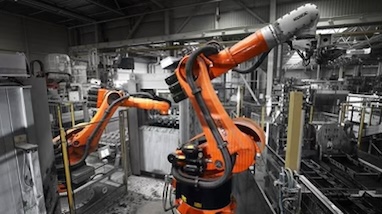 Image courtesy of KUKA The four packages essentially run from smallest to largest and lowest to highest cost, and each one comes with Ai Build's Ai Sync software, as well as a different combination of KUKA robotic arm and Dyze Design pellet extruder. For instance, the smallest package — the "Small but Mighty" — contains Dyze Design's Pulsar Pellet Extruder with an extrusion rate of 2 kg per hour, and KUKA's LBR iiwa robot, which has an 820 mm reach. The largest package, the Long Arm Super Heavy, has an extruder with an output of 84 kg per hour, and the KUKA KR QUANTEC, which has a reach of 3,904 mm. Additionally, EVO 3D, as it does with the other products it sells, offers full technical support as well as staff training for the systems it installs for its customers. 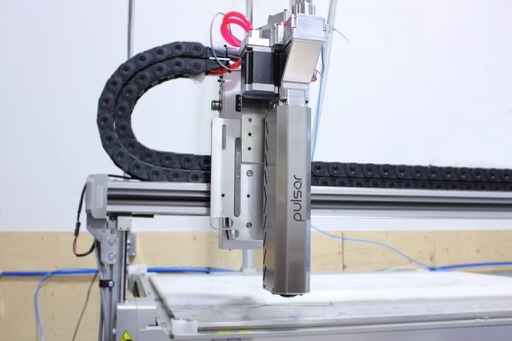 Image courtesy of Dyze Design Robotic pellet printing is most often employed for large end-products, such as components for the aerospace and automotive industry. The advantages to the technology don't just include speed and efficiency but, equally, cost: for a given kind of plastic, pellets can be anywhere from 65 to 90 percent cheaper than filaments. Moreover, plastic pellet printing, as EVO 3D also touts on its website, probably simplifies the use of recycled materials more than any other 3D printing technology, facilitating a readymade circular economy for customers. The particular technology at hand is one that is inherently both complex and versatile, so this type of offering lends itself especially well to the business model that EVO 3D is deploying here. In general, though, you could see this increasingly become the norm the more the industry grows. Legacy tech companies have already been moving more and more to a subscription-based model. The format here — three different hardware and software companies integrated by a service provider — is one that would eventually be perfect for subscriptions or leases. Building a subscription model into the equation from the beginning would make it easier for companies to both scale up and control costs. And, most importantly, it would be a significant contributor towards minimizing the industry's long-term carbon footprint. The post Four New Robotic Pellet 3D Printer Packages Offered by EVO 3D appeared first on 3DPrint.com | The Voice of 3D Printing / Additive Manufacturing. |
| Issey Miyake Brand 3D Prints High-End Sandals with Magarimono Posted: 26 Apr 2022 06:00 AM PDT For more than two decades, Japanese luxury label Issey Miyake set out to weave the future of fashion with its revolutionary A-POC (A Piece of Cloth) brand, and in 2021 it aspired to push the boundaries of creativity even further with the spin-off A-POC ABLE led by designer Yoshiyuki Miyamae and his engineering team. Working hard to deliver inspirational pieces, the brand's latest project is a pair of unisex sandals featuring 3D-printed soles and hand-woven cords. Done in collaboration with Japanese designer footwear brand Magarimono, the "TYPE-III Magarimono project" shoes are inspired by the design of traditionally hand-woven thonged Japanese sandals made with natural fibers, commonly known as zōri. So by integrating 3D printing technology and a centuries-old craftsmanship tradition, the duo has created an unprecedented product. 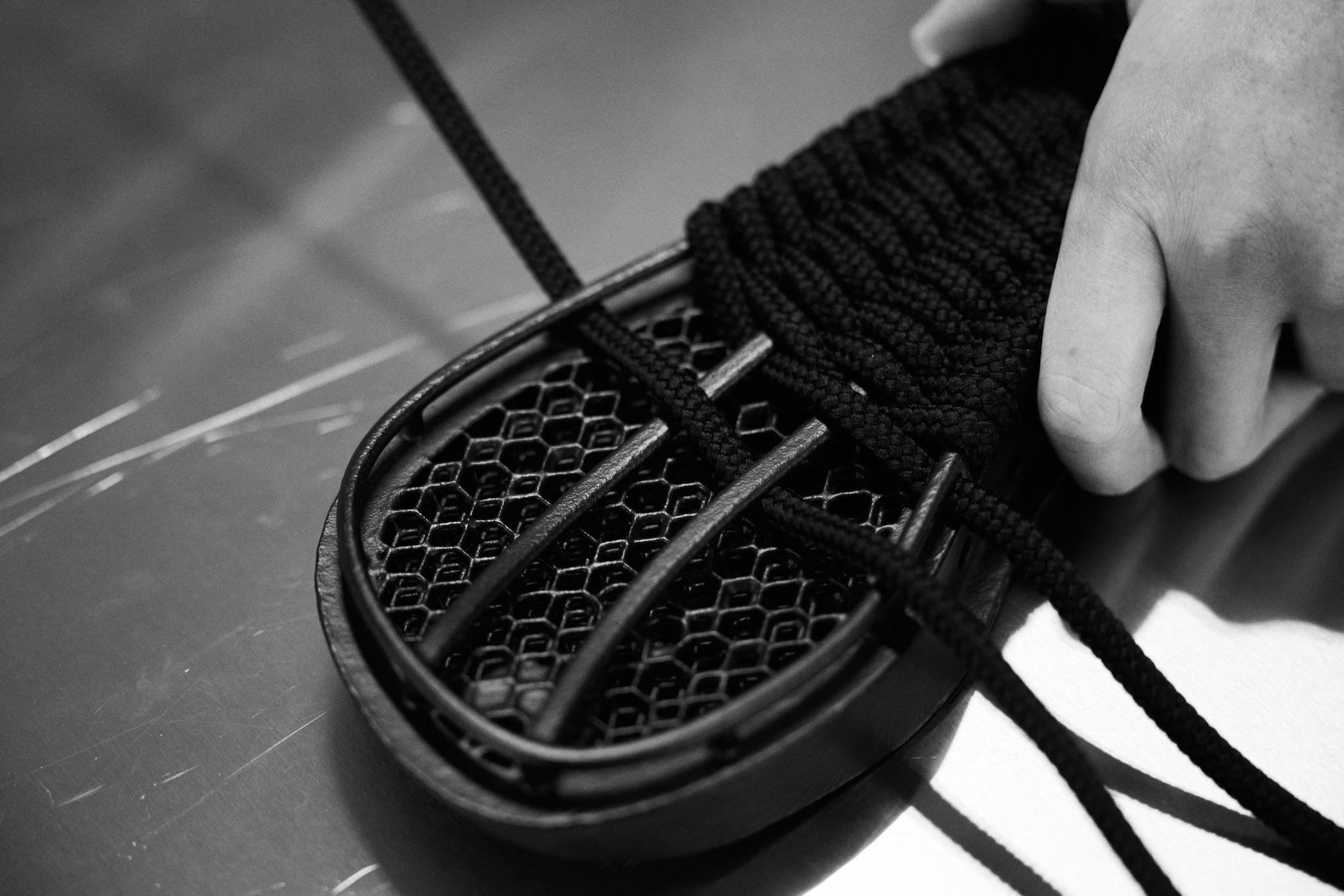 A-POC ABLE by Issey Miyake and Magarimono have created sandals with 3D-printed soles and woven cords. Image courtesy of Issey Miyake Inc. For this project, the designers relied on 3D printing technology to create a unique sole whose structure allows cords to be hand-woven directly into it. In fact, the braided part functions not only as a design but also as a cushioned insole, making this pair the result of technology, handicrafts, and comfortable footwear. After more than a year in the making, the “TYPE-III Magarimono project” was finally revealed on March 25, 2022. A marriage of art and fashion, the sandals are being sold at Issey Miyake's flagship A–POC ABLE stores in Tokyo and Kyoto and the original Issey Miyake shops in Marunouchi, Tokyo, and Semba, Osaka. Designed and printed with environmentally friendly materials, the black sandals cost ¥ 88,000 (roughly $680). 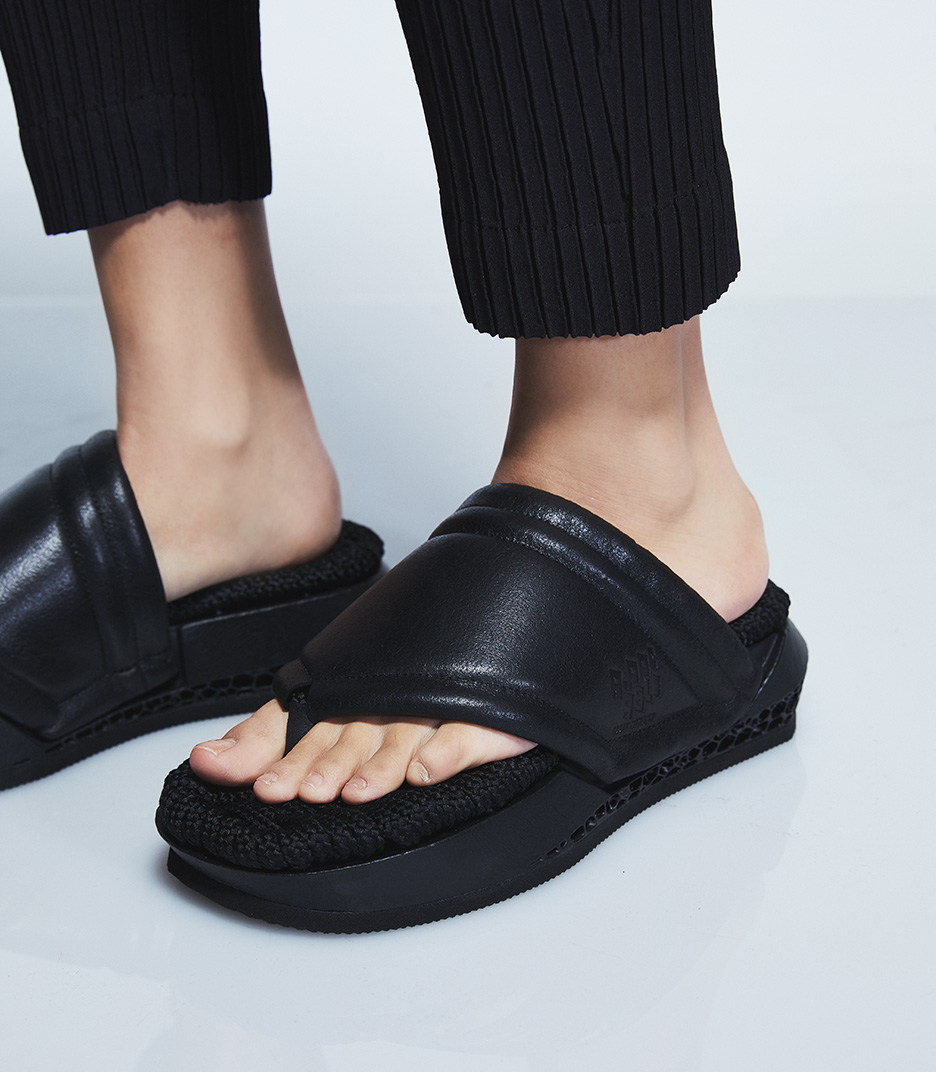 A-POC ABLE by Issey Miyake and Magarimono have created sandals with 3D-printed soles and woven cords. Image courtesy of Issey Miyake Inc.
For this project, Miyamae evaluated how Magarimono designed 3D printed footwear for its genesis model, the “Originals” collection. He soon realized that once free from the restrictions of mass production, the technology allowed designers unlimited creativity. As a result, like all Magarimono's exclusive designs, "Originals," shaped like a cumulonimbus cloud motif, launched in 2020 to become the first fully 3D printed sneaker sold in Japan. Following the footwear's success, the brand even chose to convert it into an NFT (Non-fungible token) to become Magarimono's first virtual sneaker. Magarimono relies heavily on 3D printing, but for its NFT virtual shoe design, it has become immersed in blockchain technology. Aside from real 3D printed shoes to wear out in the street, the brand began selling several collectible virtual sneakers as NFT. Buyers can try the shoes in a metaverse world where they have access to 3D avatars. Piggybacking on Magarimono's previous creation, the designers at A-POC ABLE have now transcended the boundaries of distinctive sneaker fashion. “TYPE-III” harmonizes both tradition and innovation and incorporates the functions and structures created by Magarimono's 3D design into products that can be used in everyday life, says Ono. So maybe someday, these sandals could also be part of the NFT universe. 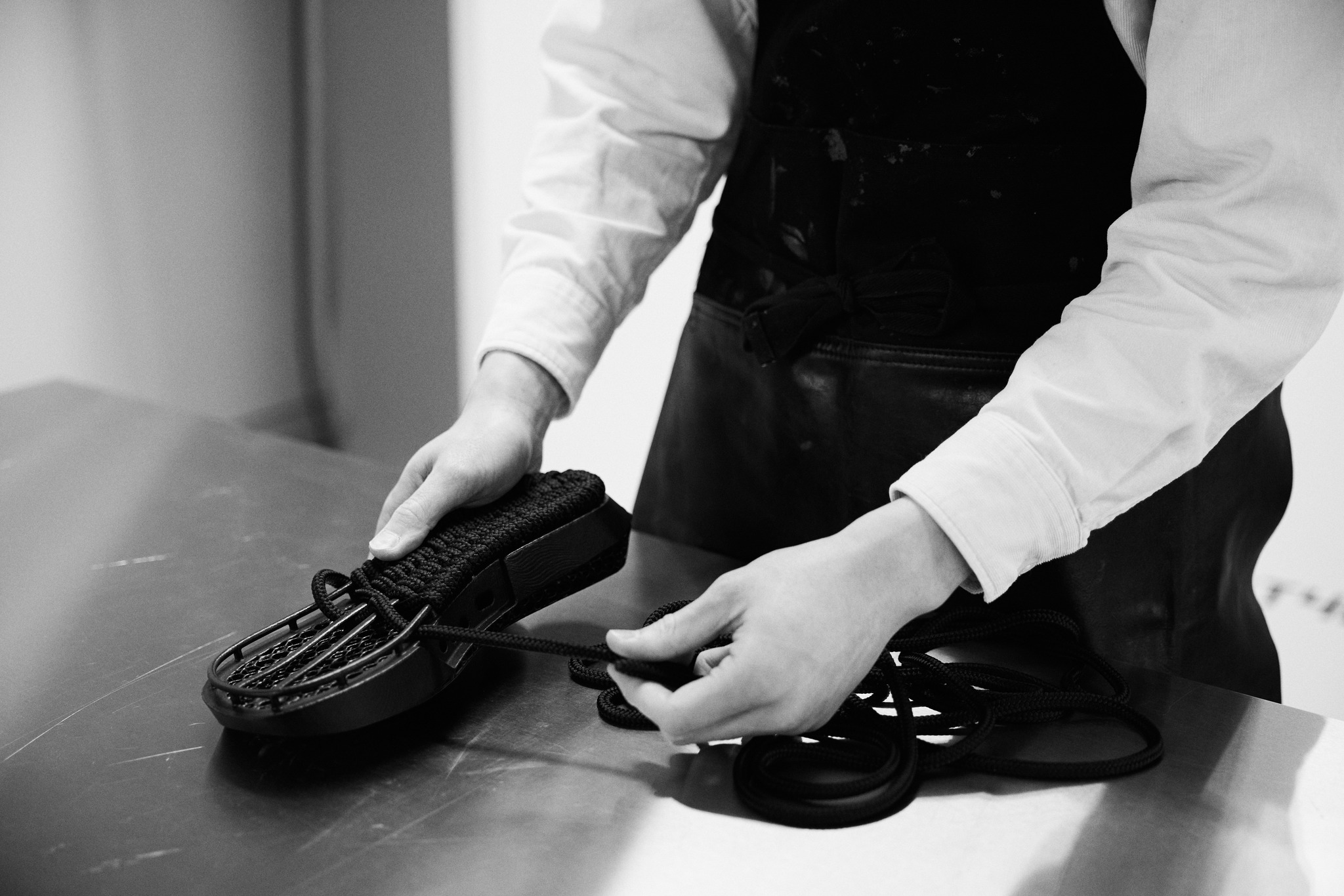 A-POC ABLE by Issey Miyake and Magarimono have created sandals with 3D-printed soles and woven cords. Image courtesy of Issey Miyake Inc. If Magarimono is known for adding a contemporary essence to traditional Japanese designs, then the collaboration with A-POC ABLE has taken that concept even further. A-POC ABLE's parent house, Issey Miyake, has been at the forefront of fashion for over half a century. The namesake fashion mogul that created the brand is well known for his forward-thinking attitude and style, which he has defined as a mixture of traditional materials with technological advancements in fashion. Miyake was quite a vanguardist, experimenting with fast-forward fabrics in the 1970s like plastic, Plexiglas, silicon, and copper cable. While learning to harness and refine some of the cutting-edge synthetic technologies of the time, Miyake also visited historic production regions and worked to revitalize traditional dyeing and production that were on the verge of extinction. 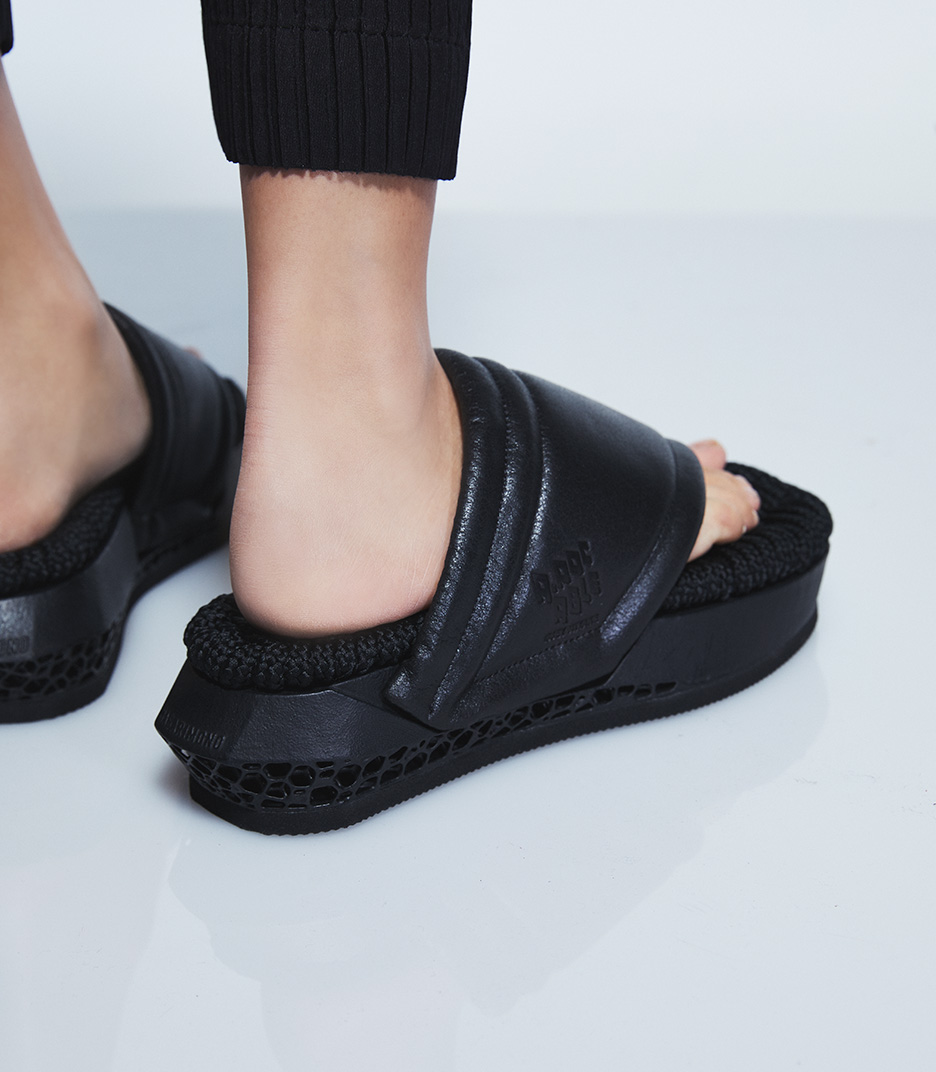 A-POC ABLE by Issey Miyake and Magarimono have created sandals with 3D-printed soles and woven cords. Image courtesy of Issey Miyake Inc. The leading designer's fascination with the synergy of technological advances and local traditions is still a big part of the Miyake house. That is quite clear in the new 3D printed and handwoven sandal design, which works as both a fashion experience and a groundbreaking innovation in footwear. A lot of Miyake's work is done in research labs instead of ateliers. With the incorporation of 3D printing into its footwear, it's only a matter of time before the brand creates a new fashion item with the technology. The post Issey Miyake Brand 3D Prints High-End Sandals with Magarimono appeared first on 3DPrint.com | The Voice of 3D Printing / Additive Manufacturing. |
| 3D Printing Drone Swarms 15: Phoenix Ghost and the Future of Custom Weapons Posted: 26 Apr 2022 05:30 AM PDT As we discuss in our ongoing 3D Printing Drone Swarms series, additive manufacturing (AM) will play an increasing role in the production of all manner of semi-sentient robots. This has been demonstrated by unmanned aerial vehicles (UAVs), which are now being made in part with 3D printing for lightweight, custom designs. For this reason, we expect AM to be used for other drone-style bots as well, often for military purposes. We are also not advocating for the use of 3D printing for the manufacturing of weapons or military equipment, but are highlighting this as a likely inevitability. Recently, the US announced that it will quickly allow Ukraine to use its Phoenix Ghost drones. According to a senior defense official, “The Phoenix Ghost… was rapidly developed by the Air Force, in response, specifically to Ukrainian requirements. This is a great example of adapting to their needs in real time." Other reports have specified that the Phoenix Ghost was created for an analogous assignment and adapted for Ukraine. Another story quotes an officials as saying that the design of the craft was "based on talking to the Ukrainians about what they need. It's very much tied to the fight that they're in, in the Donbas and what that region, from a terrain perspective, portends for the use of force.” Regardless of how exactly it was developed and deployed, the fast process of moving this unmanned aerial vehicle (UAV) from the R&D labs and to the frontlines points to agility in engineering and deployment.  IAI´s Harop loitering munition. Image courtesy of IAI. Many know that the U.S. military’s procurement system is broken. The military spends way too much money waiting far too long to get the kit it wants. Russia’s invasion of Ukraine has forced militaries to react quickly. Many are trying to balance Ukraine’s needs with maintaining reserves. Others wish to provide equipment, but not the latest and greatest. The situation in Ukraine is also unique, with the nation’s defenders facing a specific enemy behaving in a specific way with specific methods, training and equipment. Indeed every conflict is unique because of situation-specific doctrines, enemy actions, the weather, the climate, level of training of the combatants, infrastructure and many other influential factors. Could 3D printing be an ideal solution to improve materiel so that it better meets current requirements? 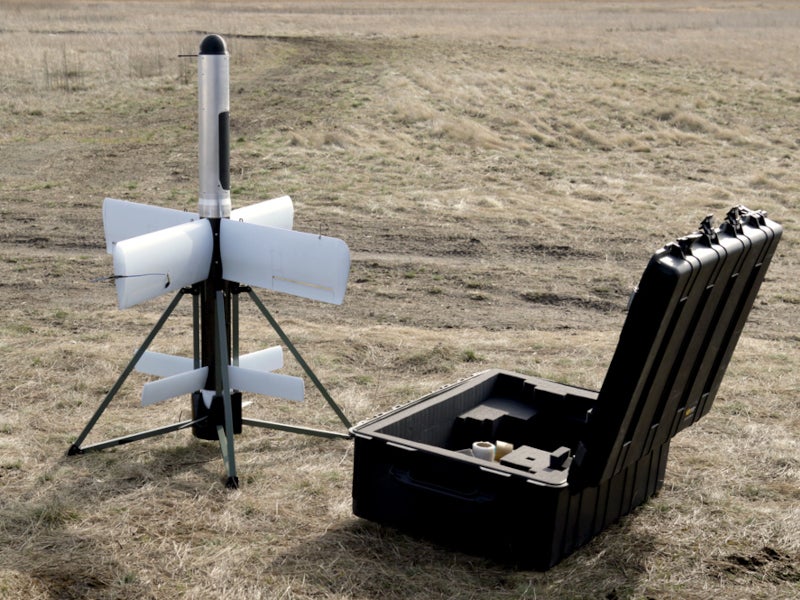 Silent Thunder, a loitering munition by Athlon Avia. Image courtesy of Athlon Avia. In our 3D Printing Drone Swarms series we’ve looked at 3D printing missiles, loitering munitions, the democratization of drones, war winners and more. On the whole, the conclusions of this series so far is that 3D printing is playing an increased role on the battlefield, especially in unmanned aerial, underwater, and ground vehicles. Why is 3D printing so important for the future of drones?
On the whole, we can see that 3D printing is a natural technology for drone development. It saves costs on product design and can reduce development time. But, there is one very important consideration that is often overlooked. By making a production process more agile and accelerating time to market, it’s possible to make customized versions of a vehicle more quickly. Up until now, the military has tried to standardize everything from shoes to aircraft. It needs to be prepared for a wide array of theaters, missions, and scenarios. So standardization makes sense. But, if we know and understand the battlefield, it should be possible to customize a vehicle to local conditions. Deployments can be accelerated and craft can be made more survivable by deploying 3D printing for tailor-made equipment. In effect, we can look at the role, landscape, climate and more, and customize a drone for the mission and theater. 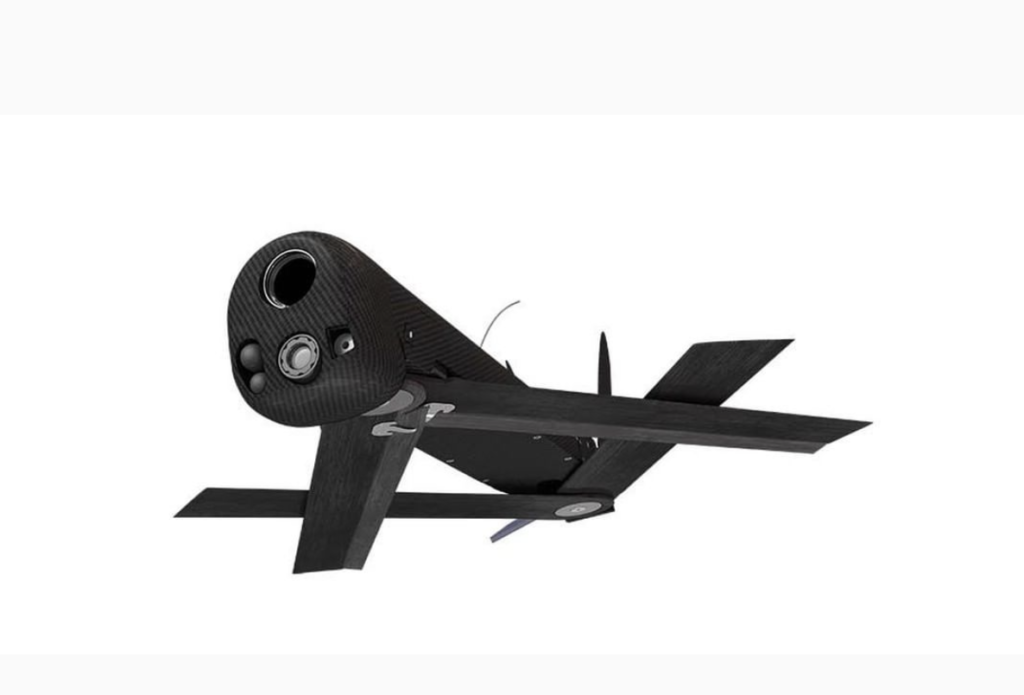 AeroVironment´s Switchblade is another loitering munition. Image courtesy of AeroVironment. In the case of the Phoenix Ghost, we’re dealing with a loitering munition that is meant to target artillery or armor. It could have a flight time of six hours and take off vertically. Imagine that this was made for a Middle Eastern climate and would not work well in Ukraine. With 3D printing, it could quickly be adapted to the local conditions. Imagine new cameras were necessary to make a UAV state of the art. New housings could quickly be design for them. Imagine the craft needed a new payload to beat more heavily armored vehicles? New mounting or payload options could easily be enabled with 3D printing. Imagine that Ukrainian users find out that the drone needs to be more maneuverable. Some quick light weighting could be performed with 3D printing. Imagine that wet weather was grounding the planes. They could be upgraded with new components that weather seal the device. Or imagine that the U.S. has some top-of-the-line Phoenix Ghosts that are good but contain some very sensitive technology. The company could be asked to quickly take out some hardware and replace it with a simpler variant to enable its sale. I think that we’re seeing a new age of warfare where, sadly, 3D printing will move to the frontline. The technology will, in turn make war more precise by tailoring drones to their current battle and terrain. The post 3D Printing Drone Swarms 15: Phoenix Ghost and the Future of Custom Weapons appeared first on 3DPrint.com | The Voice of 3D Printing / Additive Manufacturing. |
| 8 Players Leading the 3D Printed Meat Revolution Posted: 26 Apr 2022 05:00 AM PDT Finding the perfect substitute for your meat seems like a mind twister. It's not just about taste; meat lovers considering a move to the "artificial meats" side will demand similar texture, tenderness, and smell. More importantly, scientists attribute the need for meat to its unique mixture. Rutgers University nutritional sciences expert Paul Breslin describes this as a blend of fat and umami, a Japanese word that means the savory or meaty taste of foods. Recreating such powerful stimuli hasn't been easy, but as the processes improve and investments pour into the alternative meats industry, the results will continue turning heads. Countries like Israel and Singapore are at the forefront of meat alternatives, particularly cultured meats. Whether it’s a 3D printed substitute for fish, chicken, pork, or cow's meat, these countries want them as part of their food services. In 2021, Forbes clearly described how Singapore is in a race to attract meat alternative companies due to the lack of locally produced foods. The move is expected to help this very small, heavily urbanized island city-state in Southeast Asia attract plenty of alt-protein players to create a more resilient food ecosystem, which currently imports over 90% of its food. On the Middle Eastern front, Israel is a powerhouse of alt-meat companies, racing to develop an alternative to just about any animal-derived product, from meat to milk and eggs. With roughly 100 alternative protein companies active in Israel, over 40 percent of those alone have the breakthrough technology that could shape the future of protein. Here, we discuss the eight players leading the 3D printed meat revolution. Aleph FarmsOne of the pioneering firms in this up-and-coming segment is the Israeli startup Aleph Farms. It created the world's first slaughter-free steak made from cow cells in 2018 and developed a scalable manufacturing 3D tissue engineering platform called BioFarm, to cultivate whole-muscle steaks. A year later, it gained prominence when its experiment aboard the International Space Station (ISS) resulted in the first-ever lab-grown meat in space. Established in 2017, this Rehovot headquartered business raised over $131 million in funding from more than 20 investors, including Leonardo DiCaprio. Ahead of an initial market launch around the end of 2022, the company is heavily expanding. Earlier this year, it opened a 65,000-square-foot facility located at Stratasys building in Rehovot. It also grew its portfolio of cultivated meat by adding a new product line of cell-cultured collagen (coming to market in 2024) derived from the cells of living cows and eliminating the need to slaughter animals for its production. BlueNaluAfter hearing about cultured beef and chicken, it wouldn't take long before a company developed a way to produce real seafood products directly from fish cells as nutritious as conventionally grown fish. Based in San Diego, California, BlueNalu relies on cellular aquaculture, a sustainable solution to farmed or wild-caught fish. To create an artificial fish fillet, the scientists initially anesthetize the fish, and a tissue sample is removed with a biopsy. Then, the fish cells are placed in giant vats and fed special nutrients to help them multiply before being 3D printed. If the startup can scale production, it could supply fish alternatives to millions of people without the bones, mercury, microplastics, and antibiotics usually associated with fish today. By challenging the global agricultural and seafood supply chain, BlueNalu is paving the way for cell-cultured seafood as a global solution and plans to commercialize its flagship products in 2023. CellXAiming to provide sustainable animal protein, Shanghai startup CellX creates cultivated meat products and plans to sell them at the same price as animal meat by 2025. Last year, the business debuted its product prototype, the first Chinese-made cell-cultured meat with a fibrous and 3D structure. During testing for the prototype of its flagship minced pork product, CellX also demonstrated three other structural product prototypes, namely, chunks of pork granules, filamentous scaffolds, and 3D bioprinted product prototypes. Focused initially on domestic Chinese pig breeds, CellX quickly expanded to beef and poultry. A pioneer in cellular agriculture, CellX has now partnered with German food tech company Bluu Seafood to find solutions for the future of food. To move forward with the plan of eliminating animal meats, CellX is at the forefront of advancing the necessary regulatory approvals in China that will parachute investment, research, and ultimately, production of cell-cultured meat. Considering that China is the world's largest meat consumer, CellX founders Ziliang Yang and Ran Liu believe there is great potential for the alternative protein market. Eat JustCalifornian startup Eat Just is selling cultivated meat. Its first product, a cell-cultivated chicken called GOOD Meat, was approved in Singapore for sale a year ago and is available at select restaurants. To create it, they use stem cells from chicken eggs, which can be cultured into the desired product. Once they have grown into edible tissue, they are then used to create a form of ink used by a 3D printer to layer it into normal-looking food. This way, the startup can create chicken-like products that taste just as good. Eat Just has been around since 2011 when founders Josh Tetrick and Josh Balk decided to venture into vegan mayo, eggs from plants, and overall plant-based alternatives to conventionally-produced egg products. Today, with over $460 million in funding under its belt, the business is looking at a post-money valuation of one to ten billion dollars, according to PrivCo. But, more importantly, its vision to build a food system that makes it easy for people to eat better is well on its way. Fork & GoodeLaunched in 2018, Fork & Goode translate tissue engineering technologies to making cell-based animal products (notably pork meat) without slaughter, damage to the environment, and with significantly fewer natural resources than the traditional industries. Like many of its competitors, Fork & Goode starts by taking a small sample (no slaughter required) of muscle cells from a live animal, in this case, a Berkshire pig living on a farm in New Jersey. Then cells receive the nutrient-rich feed, just like a pig would, and by the time the cells reach the desired yield, scientists harvest the meat. Finally, partner chefs add their own flair and cook Fork & Goode pork in their favorite recipes. The startup stands on the shoulders of Garbor Forgacs’s work. A theoretical physicist turned tissue engineer, Forgacs pioneered 3D bioprinting to build functional living structures, tissues, and organoids. Moreover, he is the scientific founder of the first commercial bioprinting company, Organovo (now being revitalized by its original CEO, Keith Murphy). After branching off from Modern Meadow, a biotechnology company that uses biofabrication to create sustainable materials, the startup began making pure animal proteins and fats that are clean, traceable, and delicious. This new approach to growing food has landed the company over $3.5 million so far, and they could start commercializing culture pork meat soon. Future Meat TechnologiesThis year, Future Meat Technologies hopes to commercialize "delicious cultivated meat." The biotech startup is a spinoff out of the Hebrew University of Jerusalem and piggybacks on the work of biomedical engineer and entrepreneur Yaakov Nahmias. He is not just the founding director of the Alexander Grass Center for Bioengineering at the Hebrew University of Jerusalem and a faculty member at the Center for Engineering in Medicine at Harvard Medical School, but the first researcher to 3D print cells for the first commercial human-on-chip technology. Through distributive manufacturing of fat and muscle cells (the core building blocks of meat), the business aims to transform global meat production into an animal-free reality. Following the opening of its first industrial cultured meat production facility in Rehovot, Israel, in June 2021, Future Meat began producing 500 kilograms of cultured meat products daily, equivalent to 5,000 hamburgers. According to the company, the small-scale production costs per pound of chicken and beef were $150 and $200, respectively, in 2019. However, the pilot production facility can bring down the cost of production to less than $10 per pound in 2022. MeaTechAt the forefront of 3D-printed alternative meats, MeaTech (NASDAQ: MITC) is ready to take over the cultivated meat industry. Its alternative to conventional farming and meat results from an advanced and proprietary process that starts by isolating bovine stem cells from tissue samples and multiplying them. Next, the Israeli business formulates bioinks compatible with its proprietary bioprinting technology to print a steak structure. Once printed, the product goes into an incubator to mature and form the MeaTech steak. Focused on developing a genuine replacement for conventional steak that maximizes cell-based content rather than non-meat ingredients, MeaTech's cultivated steak comprises real, living muscle and fat cells and does not contain any soy or pea protein typically used in plant-based alternatives. In 2021, the company acquired Peace of Meat, now its Belgian subsidiary, and established MeaTech Europe. Ending the year with the world's largest-ever 3D printed cultivated steak, the company promises groundbreaking results. To propel the company's go-to-market strategy, MeaTech partnered with the BlueSoundWaves collective, led by Ashton Kutcher, and plans to open a pilot plant in Belgium to accelerate the production of cultured chicken fat. Shiok MeatsSingapore's Shiok Meats works with 3D printing technology to add texture to synthesized lab-grown crustacean meat for human consumption. The first of its kind cultivated meat and seafood company in the country and the South-East Asia region, Shiok currently produces crustaceans like shrimps, crabs, and lobsters using cellular agriculture technology. In early 2019, Shiok Meats unveiled its prototype, eight shrimp dumplings (Siew Mai) that cost S$5,000 ($3,600). Then a year later, it showcased the world's first-ever cell-based lobster meat. Shiok is on track to commercially launch its cultivated crustaceans by 2023, at $50 per kilo. Likely to be in “minced form,” the final product will be launched in a premium restaurant in Singapore. The post 8 Players Leading the 3D Printed Meat Revolution appeared first on 3DPrint.com | The Voice of 3D Printing / Additive Manufacturing. |
| 3D Printed Sharkskin Patterns, Fire Resistant Coating & More Honored for Sustainability Posted: 26 Apr 2022 05:00 AM PDT RadTech has recognized three companies for their leadership in sustainability through 3D printing technology as part of its annual sustainability awards. The nonprofit association, known for promoting the use and development of ultraviolet (UV), electron beam (EB), and light-emitting diode (LED) technologies, selected four winners in 2022. Each represents a different sector of the UV/EB/LED end-user market, and each offers a unique product sustainability advantage. From Sydney, Australia, RadTech chose MicroTau for their microprinting technology work to improve airliner performance. The company found a way to recreate sharkskin patterns that reduce aerodynamic drag, which helps increase flight efficiency and performance. Working out of a small lab in the University of Sydney's School of Physics in 2015, MicroTau Founder and CEO, the experimental physicist and entrepreneur Henry Bilinsky, developed a new fabrication technique. Combining computer chip fabrication and ultraviolet-curable coating technology, Bilinsky's method uses light to print drag-reducing microstructures, called riblets, into aircraft paint to reduce fuel consumption. These riblets were initially discovered by looking at sharks' skin under a microscope and noticing that millions of years of evolution have made its ridges decrease drag so sharks would become more efficient hunters. At the time, Bilinksy and his startup even won a contract with the U.S. Air Force, seeking a way to reduce fuel consumption on their legacy transport aircraft. 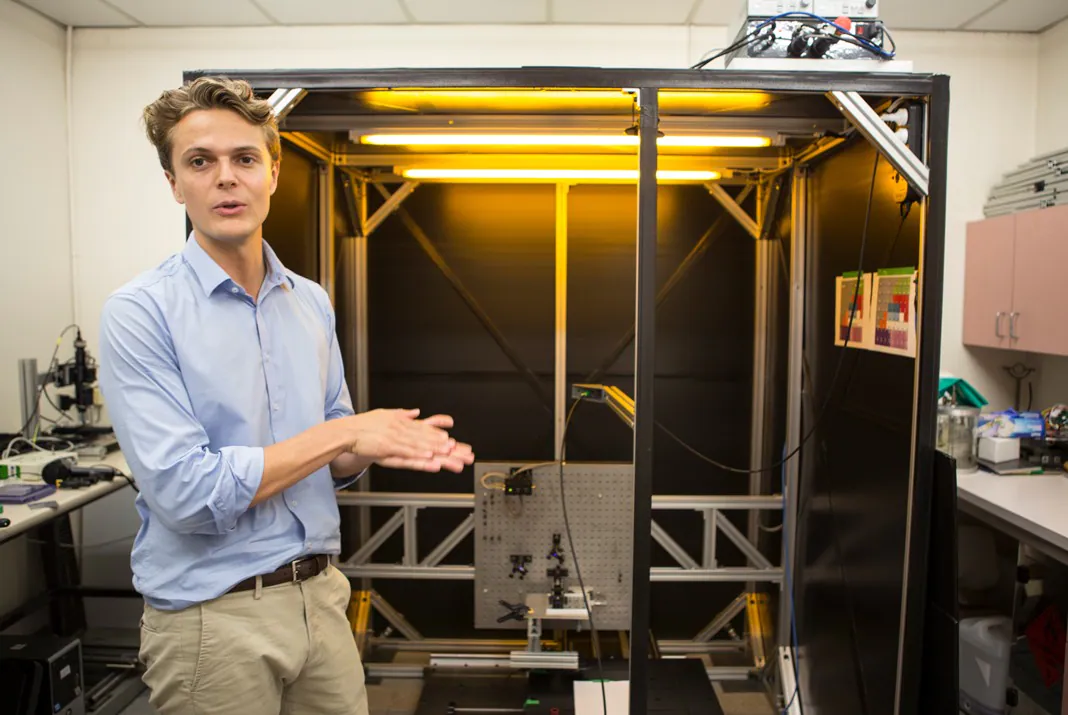 Henry Bilinsky, in his lab at the School of Physics, explained how the prototype prints sharkskin structures onto a surface using light. Image courtesy of the University of Sydney. Like many other startups, MicroTau is a bioinspired business looking to nature to solve humanity's problems. According to the company, the natural microscopic patterns found on plants and animals have functional properties, so the group decided to create a proprietary new advanced manufacturing process called Direct Contactless Microfabrication (DCM) technology, or "Nature's 3D printer," which replicates these microscopic patterns and can also reproduce its valuable qualities. MicroTau's DCM recreates microscopic patterns with light and is scalable to large surfaces. As a result, it has the potential to offer faster, cheaper, more versatile microfabrication, at least an order of magnitude improvement over existing technologies. In addition, it can print out current UV curable coatings used in industries like aerospace, shipping, and energy. By recreating sharkskin patterns, MicroTau can reduce aerodynamic drag. So far, it grows these patterns out of UV curable coatings and has demonstrated performance in wind tunnel and flight testing; in fact, 3D printed riblets reliably showed 7% drag reduction. Considering that aircraft and ships spend most of their fuel overcoming drag, MicroTau's innovation can save commercial aviation, maritime, and energy industries more than $10 billion in fuel costs and as much as 100 million tons of carbon emissions annually. In addition, MicroTau is scaling up its manufacturing to deliver the technology to airliners and improve sustainability. Wood that doesn’t burn?Additionally, RadTech chose Texas A&M University researchers Thomas Kolibaba and Jaime Grunlan as recipients of its "Special Academic Award" for their work on fire-resistant wood coatings that limit the flammability of wood used in construction. This environmentally friendly process could also be applied to other flammable materials, such as photopolymer 3D printed parts. With the potential to mitigate the spread and damage of fire, the newly developed coating treatment doesn't have many of the drawbacks typically associated with fire retardant solutions, including the toxicity of commercially available halogenated flame retardants (these are being regulated out of the marketplace due to health and bioaccumulation concerns). The application of this technology has the potential to be used in a variety of markets, including compatible wood treatment solutions and fabric finishing textile treatment. In fact, Kolibaba suggests that UV-cured polymers could also be used as a resin to make 3D printed parts that are otherwise flammable when produced with conventional resins. In addition, he observed that this could be a significant advantage in aerospace applications, including the International Space Station. This is not the first time Kolibaba has incurred in additive manufacturing solutions. Last year, the graduate student and postdoctoral researcher at the university's Grunlan Lab published a paper on an environmentally benign flame retardant polyamide‐6 filament for 3D printing and was previously engaged in research on a self-extinguishing AM filament. For his latest coating development, there is also potential as a preventive measure against future forest fires. Ultimately, the team behind the invention hopes that the coating will become accessible to anyone who needs it, allowing those who live in high-risk areas to treat their own homes and property with the coating to protect against fire damage. Finally, award winners Water Gremlin from White Bear Lake in Minnesota, and the duo Thistle and Bee from Memphis, Tennessee, and GOpak Flexibles from Delafield, Wisconsin, also came up with ingenious developments. Water Gremlin has implemented a solvent-free UV curable coating process for battery terminals with less environmental impact than traditional coatings. While Thistle and Bee and GOpak Flexibles created flexible yet sustainable packaging for GOpak's granola bars using 100% recyclable material and electron beam curing to make the packaging safe for consumption. Winners will be celebrated at the Awards Dinner during RadTech 2022, taking place May 9 through 12 in Orlando. The post 3D Printed Sharkskin Patterns, Fire Resistant Coating & More Honored for Sustainability appeared first on 3DPrint.com | The Voice of 3D Printing / Additive Manufacturing. |
| Canada’s First 3D Printed House to Be Built by Habitat for Humanity Posted: 25 Apr 2022 06:30 AM PDT Habitat for Humanity of Windsor-Essex has announced it will be constructing what it's billing as Canada's first 3D printed residence, to be located in Leamington, Ontario — just across the border from Detroit. Habitat will be partnering on the project with the University of Windsor-Essex and InvestWindsorEssex (IWE), a nonprofit development organization managed by the county of Essex and the city of Windsor. Some funding is also being provided by the Canada Mortgage and Housing Corporation's Innovation Fund. Habitat, of course, is one of the world's most far-reaching nonprofits, as well as one of America's largest private homebuilders. The 501(c)(3) organization has also quickly become one of the leading global adopters thus far of additive construction (AC) technology. Since last fall, Habitat has printed houses in multiple U.S. states, as well as funded a company printing houses in India. Another company, Horizon Legacy Group, also announced last fall, and again this past March, that it was building Canada's first 3D printed residence. Horizon is planning on building an entire 3D-printed community, however, so it's possible Habitat, which expects to finish this project by the end of summer, will be done first. Ultimately, the homes will be part of a larger residential community managed by the Bridge Youth Resource Center, a nonprofit for homeless individuals aged 14 to 24. 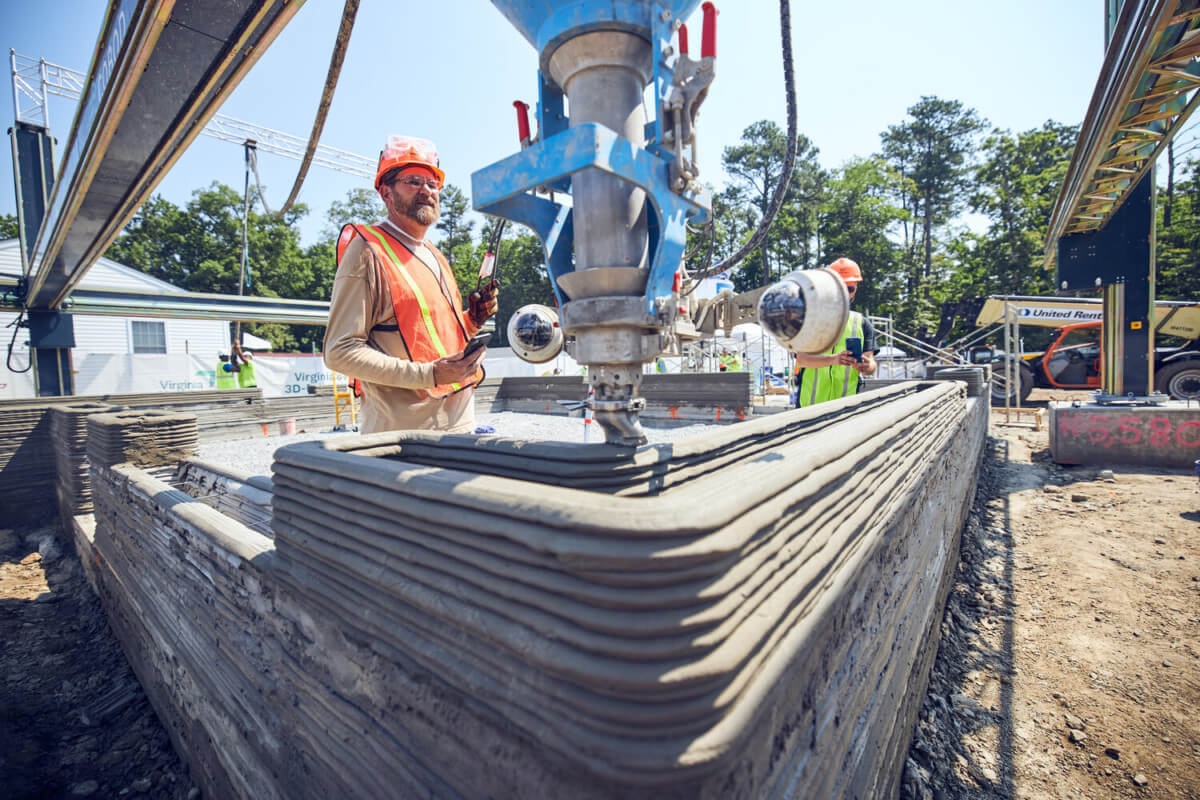 Habitat will be printing a group of four tiny homes within the community, each one about 500 square feet. This is more similar to the most recent project it has collaborated on in India — involving houses that were about 700 square feet — rather than the most recent projects the organization has partnered on in the U.S., which were substantially larger. It's unclear, as yet, what machine the homes will be printed on, but on the U.S. projects, Habitat and its partners used COBOD's BOD2 printer. What's unique about this project is that IWE used CAD models to create a virtual reality (VR) cave for the homes that Habitat will build, the main purpose of which is to anticipate and revise any potential flaws in the design ahead of time. To create the simulation, IWE team fed the initial CAD drawings of the homes into Unity, a software platform originally designed for making video games, but which has also, over time, spread into a variety of industries, including architecture and construction. Aside from facilitating customization, VR could significantly expedite the lengthy and rigorous approval process for homebuilding, according to IWE's president and CEO, Stephen Mackenzie. 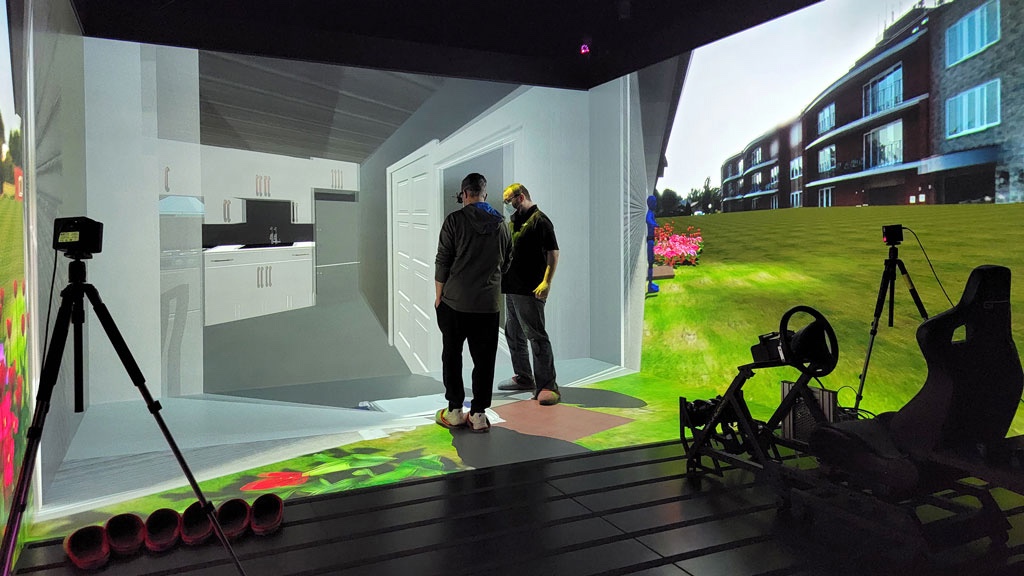 Depending on whether or not tiny houses and other prefab houses in general continue to take off, as well as, similarly, to what exact extent AC techniques end up being adopted by the larger homebuilding industry, the construction sector could turn into an unexpected catalyst for 3D printed mass customization. This would only happen, if the 3D-printed housing sector also succeeded at making more affordable homes more widely available, which is of course a far more critical goal. But, if that does eventually happen, one additional, possible effect of this could be the "democratization" of customizing your home, which at this point tends to be something that's exactly as possible as you are wealthy. People who rent their home or apartment in America, for instance, often have very little legal right to change anything at all about their living quarters. If 3D printed homes end up making housing more affordable, it would likely also make customizing your house more affordable. Aside from this, the most promising aspect of the project is, as IWE's president noted, the potential for speeding up the process of safe, affordable housing being made available. This is just as true in Canada, one of the most sparsely populated countries in the world, as it would be anywhere else. One trade-off for lower population density is greater difficulty and expense in building houses, meaning that if this project is a success, Canada could end up being a logical market for the AC sector to find a foothold in. The post Canada’s First 3D Printed House to Be Built by Habitat for Humanity appeared first on 3DPrint.com | The Voice of 3D Printing / Additive Manufacturing. |
| AI Software Brings Smart Quality Control to 3D Printing Posted: 25 Apr 2022 06:00 AM PDT A startup out of Purdue University, dubbed Araqev, is using machine learning (ML) to improve quality assurance (QA) for 3D printing. Started by Arman Sabbaghi, an associate professor in Purdue’s Department of Statistics, the software applies ML to point cloud data from scans and design files. This allows the tool to predict and plan future deviations in CAD models, thus resulting in fewer errors. Describing his tool in further detail, the professor said:
Quality control has always been a stumbling block for 3D printing. QA methodologies have been developed for production processes like CNC, in which a known material is cut away from a known material. Additive manufacturing (AM), however, builds up parts by solidifying many layers atop one another. The layers could be constructed in novel ways for the same part. They might bond and solidify in completely different ways, depending on the shape of the part, its placement related other components, or location on the bed. Depending on the process, air bubbles, filament ovality, or soot could interfere with printing. Therefore, when it comes to 3D printing, there is an increased need for QA as compared to other technologies. I personally believe that we need to QA every single object coming off of a printer. This is why I’m so excited about Lumafield but also Araqev. Based on a paper published in Technological Forecasting and Social Change in 2016, Sabbaghi suggests that quality control can lead to $2 billion in global losses annually for metal AM. The opportunity for Araqev is therefore potentially huge. So far, Sabbaghi and his team demonstrated the possibilities using a Metal X 3D printer from Markforged. According to the company, Araqev’s algorithms were able to cut inaccuracies in the shape of the 3D printed parts by a significant amount.
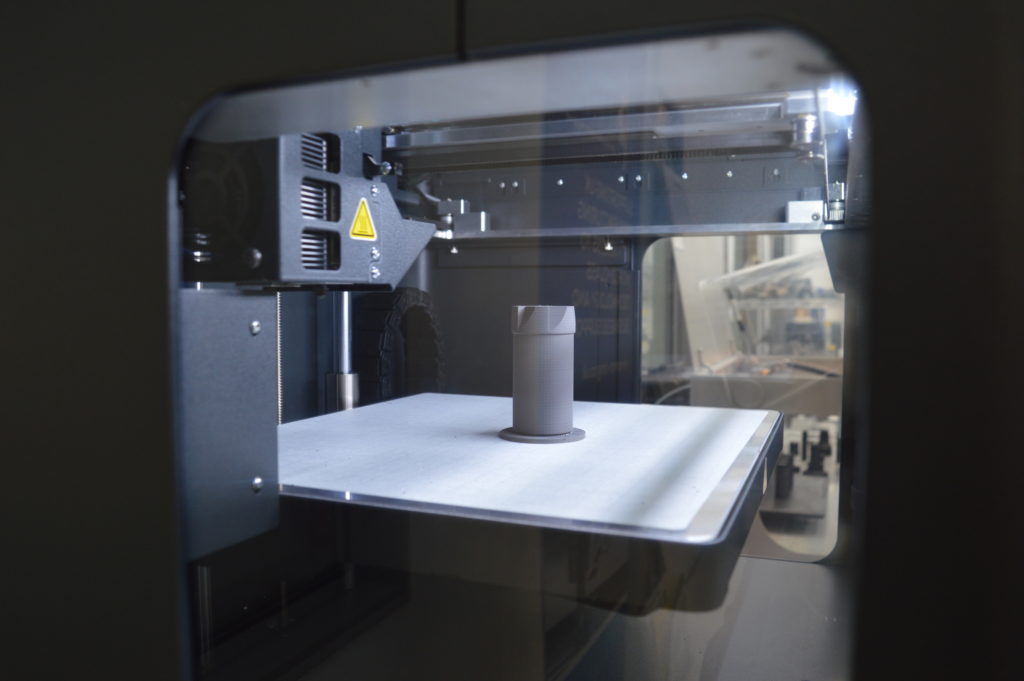 A cutting tool being made on a Markforged Metal X. It’s early days yet for the company, but these kinds of numbers seem quite powerful. Also the progress is remarkable given the limited data that they have used. The company’s go-to-market aims to leverage the distribution channels of a 3D printer OEM to sell Araqev software, licensing it to these partners to quickly grow. Of course, this is a very limited and highly dependent way to approach the market. In some ways, we’ve seen this previously with companies like SABIC reliant on Stratasys to sell its ULTEM materials into the market. It is a very fast, low-capital, low-headcount method to approach a new market and scale. However, success would be highly dependent on how OEMs incentivized their channel and sales people to sell the software. If these incentives were not considerable or well-delineated the company could fail through no effort of its own. Establishing good partnerships with a firm that considers this as a way to sell to an installed base, while incentivizing its people well, then Araqev could be successful. However, the startup will be dependent on the OEM’s efforts and rely on the OEM for revenue. Not only does Araqev not own the customer, but it will gather little market intelligence in this way. For QA, it would be especially important for the firm to find out from the shop floor what the QA challenges are. Are people working with unique parts or series of parts? How big are those series? How big is the variability. Is labor power a problem? This is all information that would really help them meet the market. This is a limiting business model and go-to-market that may seem like a good approach, but which has many risks. Generally, however, this is an encouraging sign especially since every machine learning cowboy will now take a gander at 3D printing and could perhaps help the industry out. The post AI Software Brings Smart Quality Control to 3D Printing appeared first on 3DPrint.com | The Voice of 3D Printing / Additive Manufacturing. |
| Saint-Gobain & More Display 3D Printed Construction at Dutch Sustainability Expo Posted: 25 Apr 2022 05:30 AM PDT It's a green city of the future at the Floriade Expo 2022. This large-scale world horticulture exhibition, which takes place once every ten years in the Netherlands, sets the stage for the future of sustainable living. Considered one of the world's major horticultural shows, the Floriade Expo is held in Almere from April 14 through October 9, 2022. Labeled as a green event, it offers visitors a lush refuge of flowers, plants, vegetables, and fruits in park-like surroundings, where they can enjoy a wide array of innovations, vibrant arts, and culture. Amid a living library of plants designed by landscape architect Winy Maas, forty country presentations and pavilions, and a real aerial cableway that runs across the expo's 60-hectare-park, several 3D printed marvels stand out. From Qatar's 3D printed buildings shaped like age-old pigeon towers to a portable, sustainable, 3D printed workspace, each gives visitors a taste of what the technology can do to enhance city life. In the exhibit's "Urban District" area, dozens of countries showcase their solutions to the major urban challenges of the future. Qatar chose to display four one-of-a-kind sustainable construction prototypes as beautiful and pragmatic architectural structures. Each tower in the pavilion's 2,000-square-meter plot has its own story and was built with different materials and techniques. There's an "Energy Tower," "Legacy Tower," and "Vertical Garden." However, the "Pigeon Tower" is what most interests us since its 3D printed. Relying on the advanced manufacturing technology and sustainable materials, Qatar pays tribute to the traditionally built pigeon coop towers in the country, also known as Burj al-Hamam in Arabic. This modern version of the dovecote is both visually beautiful and practical. Like its predecessors, the 3D printed tower provides shelter for more than a thousand pigeons during the migration season and consequently delivers ecological farming. Owing to the clever construction, pigeon droppings can be collected and used as fertilizer for local farms. Since many wild pigeons now use the tower, visitors can go up close to the 3D printed construction (at their own risk). Designed by Wittteveen+Bos and the Expo Pavillion Group, the "Pigeon Tower" was printed by Saint-Gobain Weber Beamix at its recently acquired construction company BAM in the Eindhoven Concrete 3D Printing factory. So far, the factory has produced a bicycle bridge, a pedestrian bridge, and the first of a series of homes, so this latest tower is among the first 3D printing undertakings by Saint-Gobain, and thanks to its 12.1 meters, it is one of the highest concrete 3D printed objects in the world. The groundbreaking design was built without steel reinforcement or poured concrete. Instead, the 3D printed construction provides an automated way to create the tower design. The tower is built with a total of 66 printed elements and weighs over 63 tons. The top stone alone adds a weight of 3.5 tons to the tower, is built on 11 rings, and closed with the massive end stone holding the construction together. In a sustainable move, Saint-Gobain has considerably reduced the energy requirement of the production process and the amount of material. As a result, up to 60% less carbon dioxide was emitted from building the towers than in traditional construction. Urban challengesDescribed as a "desert nest," the Qatar Pavilion merges traditional concepts with cutting-edge 3D printing construction methods and sustainable materials. In line with the Expo's theme of "Growing green cities," Qatar commissioned the multi-disciplinary consultancy group, Dar, to provide the plot’s advanced concept design, master plan, landscape, and architecture. The result is what Dar describes as a "legacy of sustainable construction practices, using renewable energy and reclaimed materials, featuring nature-informed parametric design and adaptable landscapes, eliminating construction waste and negative externalities, and employing advanced building practices such as 3D printing." 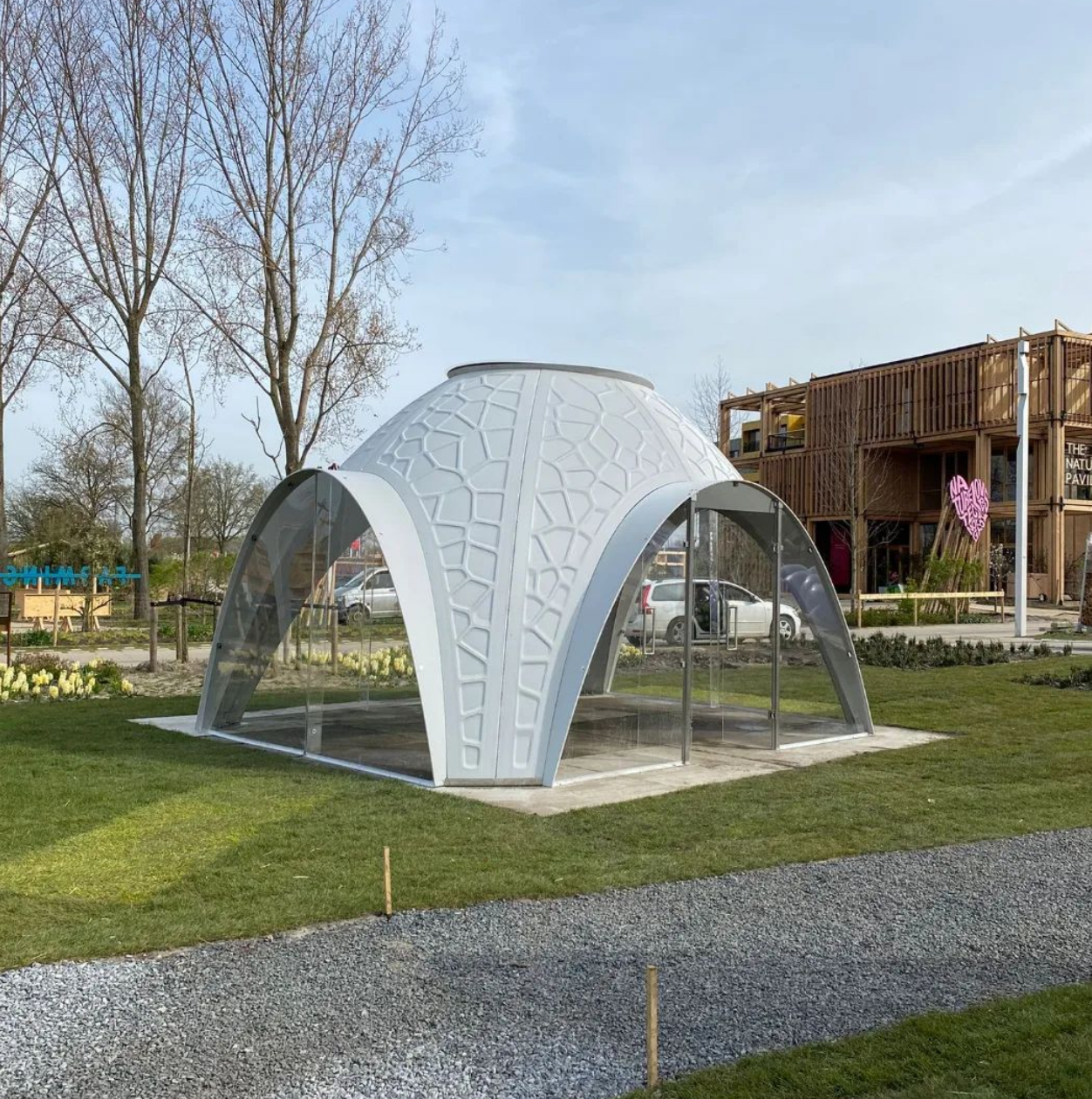 Visitors can see the R-Iglo at the Flevo Campus site in the Floriade Expo 2022 in Almere. Image courtesy of Royal3D. All eyes may be on the Qatar pavilion's unique structure, but other innovative uses of the technology are also sharing the grounds. For example, visitors wandering through the lush corridors can also see a 3D printed structure called R-Iglo at Flevo Campus, a scientific knowledge hub on urban food issues for the future. Printed by Royal3D from recycled PET waste material collected from the port of Rotterdam and reinforced with 30% glass fiber, this portable, sustainable, and multi-functional R-Iglo workspace fits any demand and location. From an event site to a garden house, exhibition stand, or even beach pavilion, the R-Iglo is quite flexible. It can be manufactured in just a couple of weeks and assembled in two days using a Continuous Fiber Additive Manufacturing (CfAM) printer built for Royal3D by large-scale 3D printer manufacturer CEAD in the Dutch city of Delft. Outfitted with ventilation, heating, electricity, and LED lighting, this original concept is modular, circular, and locally produced. Moreover, since the construction uses linkable panels of different sizes, the entire pavilion is easily assembled, disassembled, moved, and stored. Owners can even include or remove additional elements to enlarge or reduce the size of the pavilion. 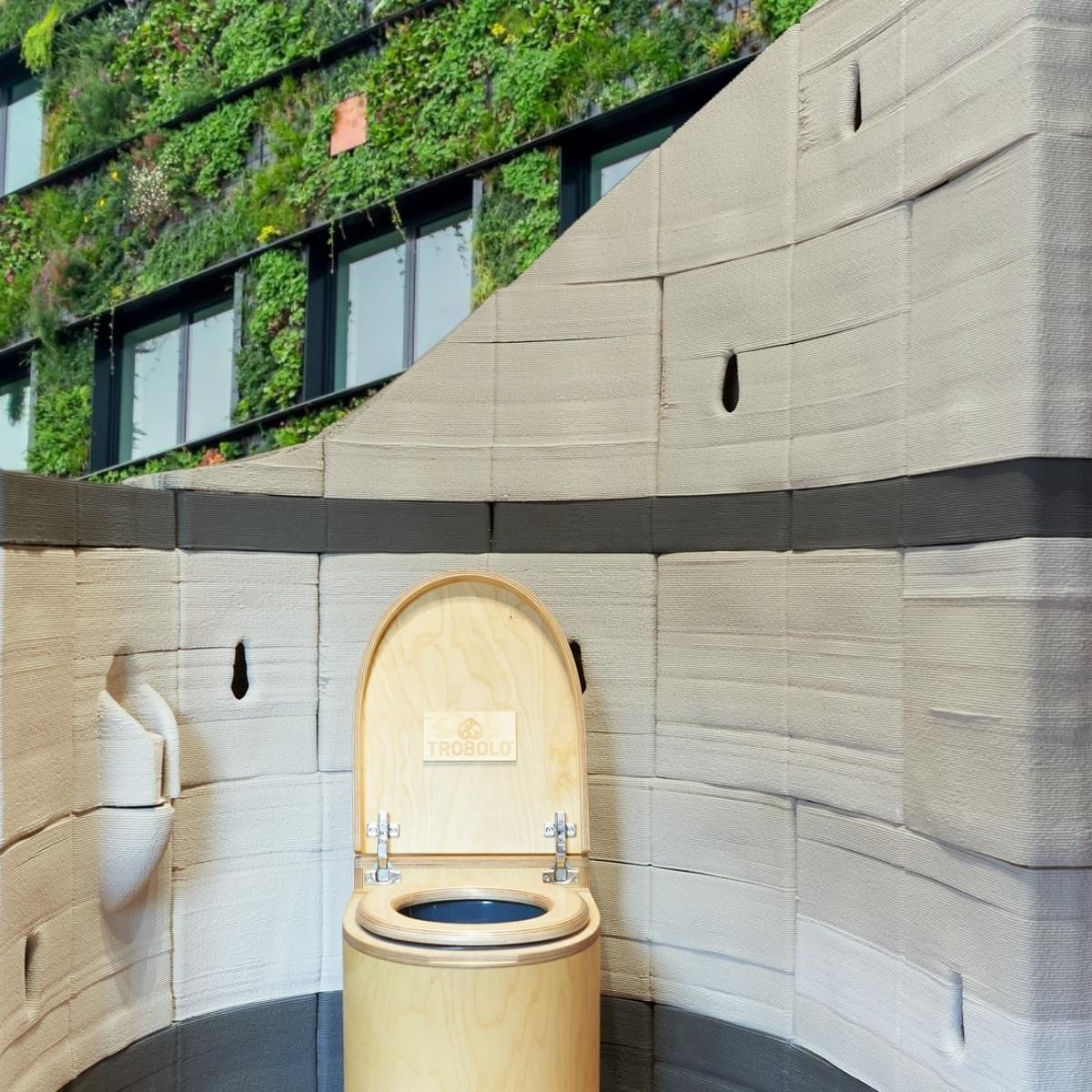 The 3D printed wall of the toilet room called “Restroom Number Two” at the Floriade Expo 2022 in the Netherlands. Image courtesy of Recell There’s also the UAE Pavilion, a 825-square-meter (8880 sqft) structure that visitors can explore at the event. The pavilion was designed by UAE-based architecture firm Pragma and 3D printed by Dutch design company Aectual. It is described as one of the largest pavilions with 3D printed facades and perimeter walls in the world. The structure features triangular 3D printed blocks that fit together to create a giant jigsaw puzzle. Inside the site’s courtyard is a building constructed from Aectual Weave panels with a custom pattern. These panels are flexible and 3D printed from a plant-based plastic. Perhaps mort importantly, the 3D printed elements are “fully recyclable” and can be reused for future 3D printing projects. Aectual offers a Circular Service for all of its interior products and architectural systems, so that they can be shredded after use and re-printed into new products. The firm estimates that its production process results in an 80 percent reduction in CO2 emissions compared to traditional building techniques. 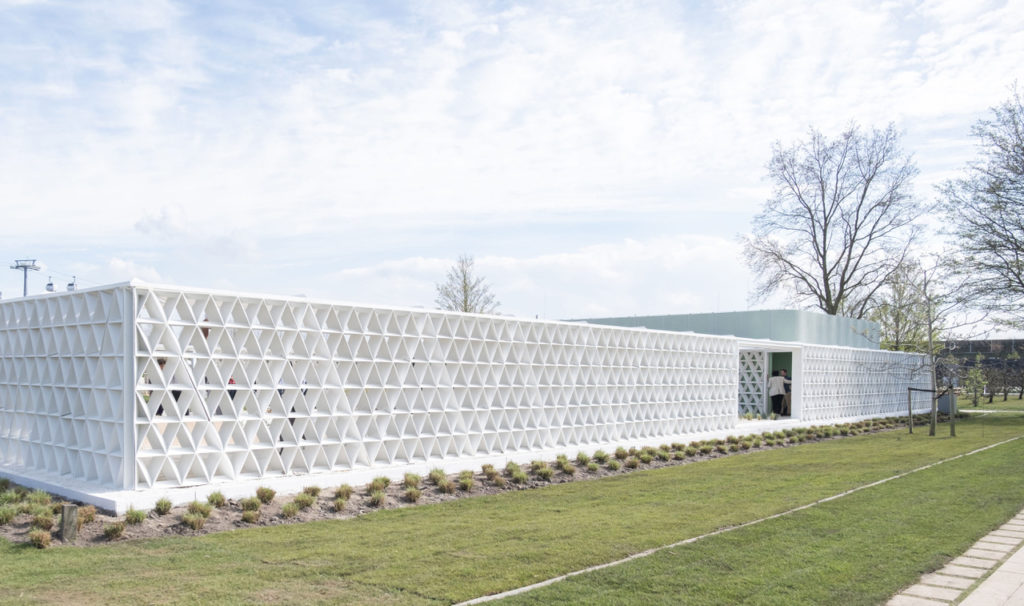 The 3D printed UAE Pavilion. Image courtesy of Aectual. Finally, visitors at the Floriade Expo can also visit "The Exploded View Beyond Building," a circular and biobased house made with several materials, including Recell, a highly sustainable cellulose-based product derived from unutilized, complex residual streams. One of the most intriguing parts of this house of the future is the wall of "Restroom Number Two," which was built by Omlab using a 3D printing paste that includes tertiary cellulose from Recell. Considering that this is a bathroom wall, it was only fitting that Omlab's 3D paste is made with recovered toilet paper from a sewage treatment plant. Albeit, this material is thoroughly purified before being processed into tertiary cellulose. The application of Recell Compose in the 3D printing paste, together with the other biobased ingredients, ensures a circular, constructively strong, and multi-usable material that is even biodegradable. Described as a "living lab" by Recell, this full-size home installation is fully circular and constructed from biomaterials and provides a unique site where visitors can see and experience what is possible with the current state of technology and knowledge. Floriade Expo 2022 has sustainability written all over. Furthermore, the expo includes some permanent buildings and innovative infrastructure, which will be used to create an innovative, sustainable residential area called Almere Hortus once the event ends. Also, an art pavilion built in the heart of the expo will be reconverted into an art museum and become one of the key attractions of the new neighborhood. The post Saint-Gobain & More Display 3D Printed Construction at Dutch Sustainability Expo appeared first on 3DPrint.com | The Voice of 3D Printing / Additive Manufacturing. |
| 3DPOD Episode 102: 3D Printing Metamaterials with METAFOLD CEO Elissa Ross Posted: 25 Apr 2022 05:00 AM PDT Mathematician Elissa Ross is a member of MESH Consultants, which commercializes mathematical solutions for practical industry problems. METAFOLD is a MESH spinout that aims to rid us of our meshes and STLs by allowing users to create intricate and lightweight lattices and other complex structures. We loved talking to Elissa and finding out how researchers can come out of left field to solve some fundamental issues that our industry has. METAFOLD is also interesting because it has a go to market challenge: How do you commercialize a way to describe and arrange complex 3D printed shapes, lattices, TPMS structures, and more? The post 3DPOD Episode 102: 3D Printing Metamaterials with METAFOLD CEO Elissa Ross appeared first on 3DPrint.com | The Voice of 3D Printing / Additive Manufacturing. |
| You are subscribed to email updates from 3DPrint.com | The Voice of 3D Printing / Additive Manufacturing. To stop receiving these emails, you may unsubscribe now. | Email delivery powered by Google |
| Google, 1600 Amphitheatre Parkway, Mountain View, CA 94043, United States | |
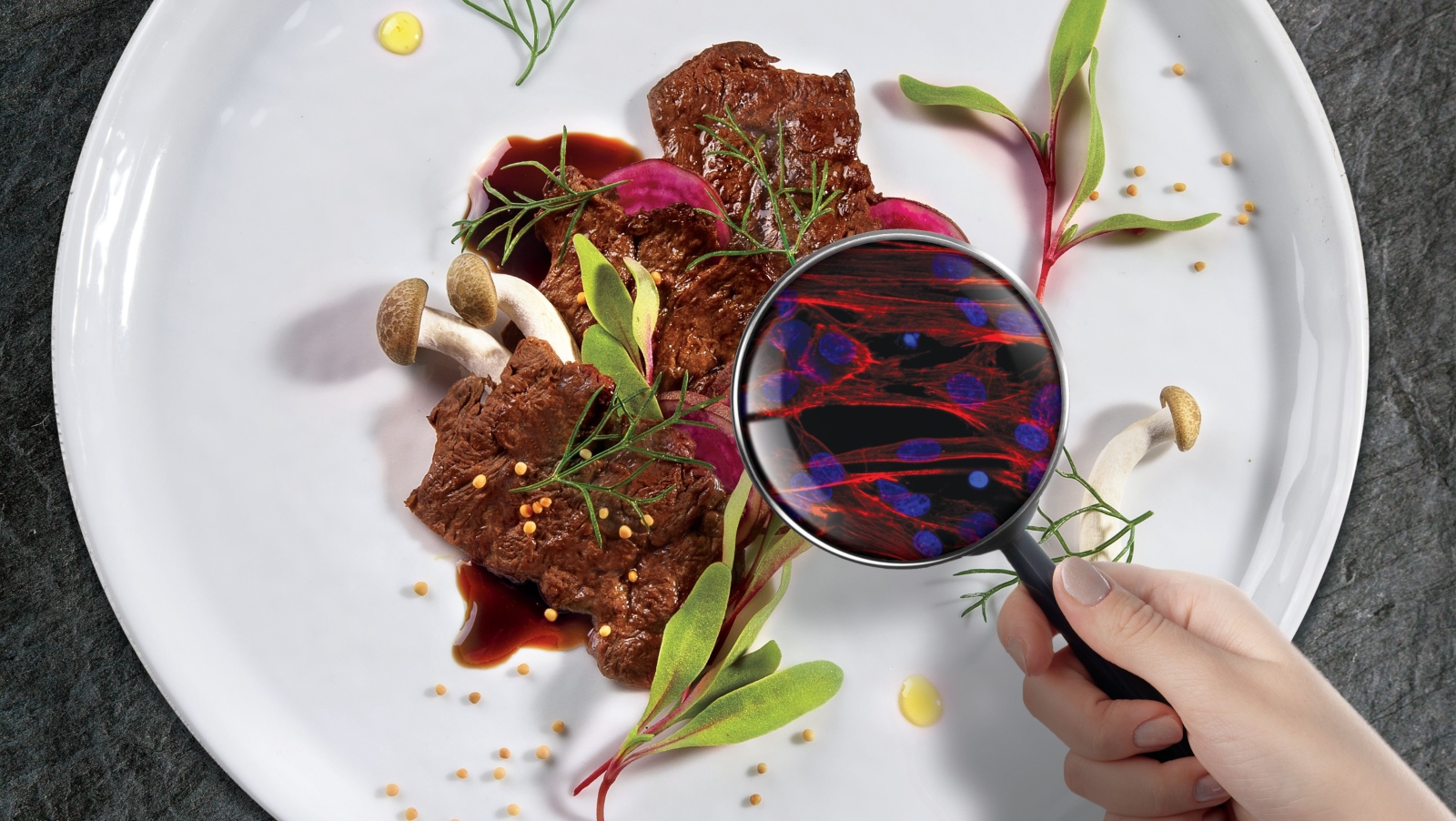

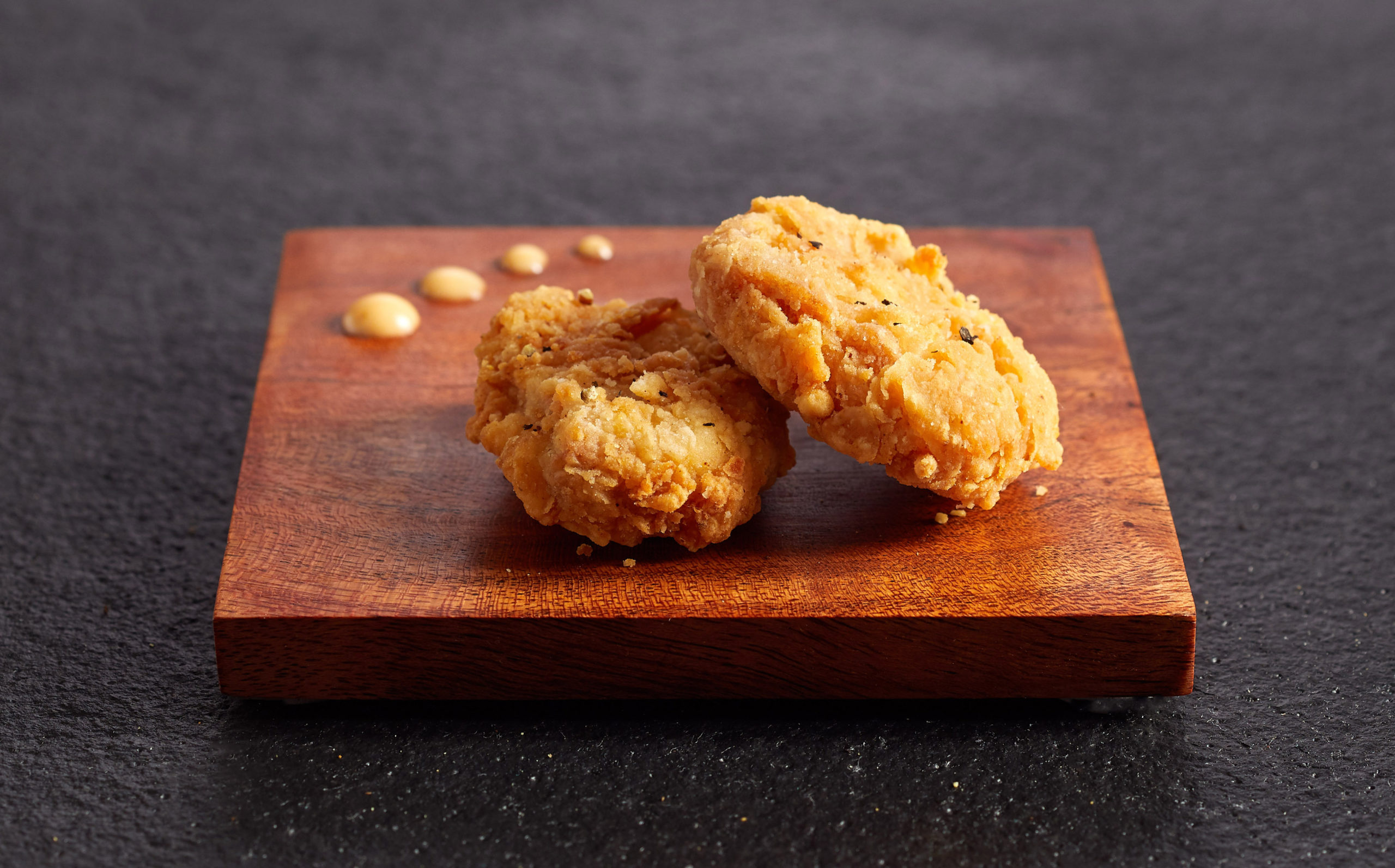
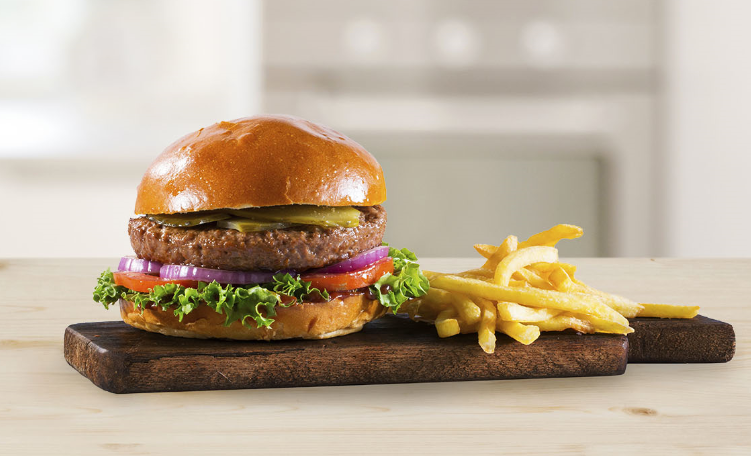

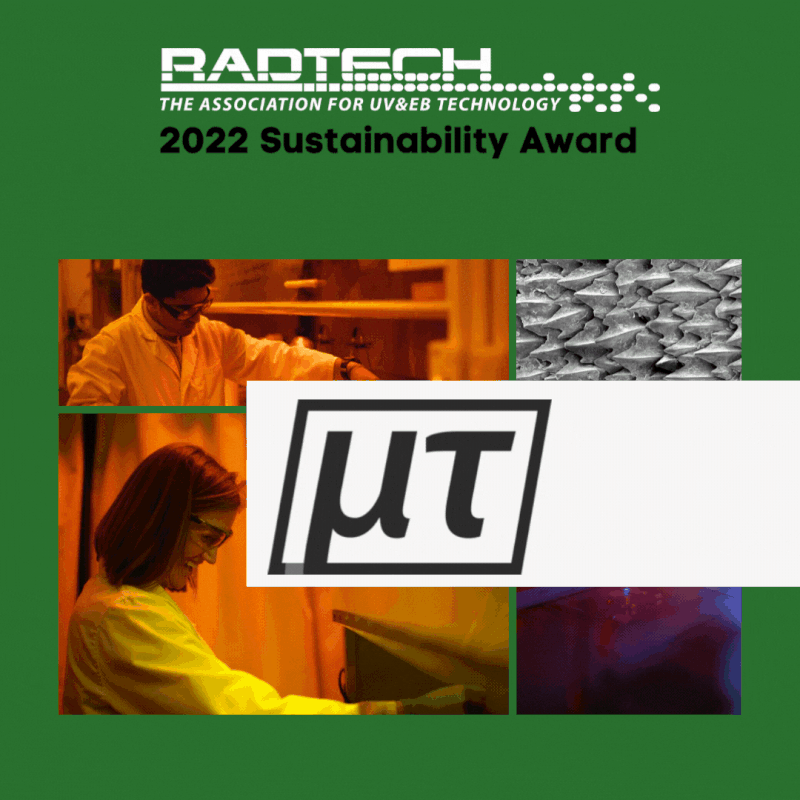

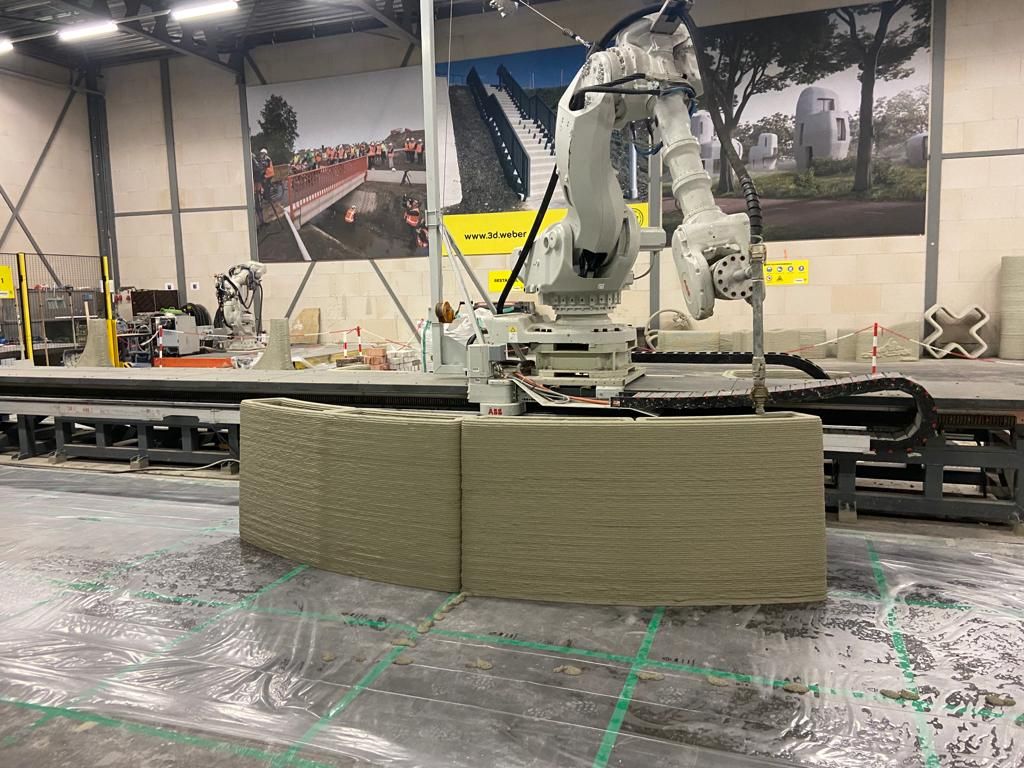

0 comments:
Post a Comment